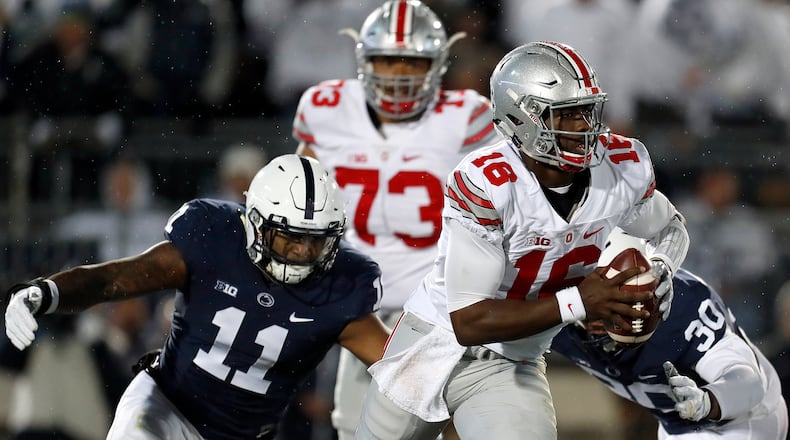Why is that?
Here are a few numbers that stand out from the Nittany Lions' advanced stats profile at FootballStudyHall.com:
1. The PSU offensive line grades out OK overall, but not when in obvious running or passing situations.
Penn State ranks near the bottom of the nation in power success and stuff rate. The same is true of adjusted sack rate on passing downs. That yields a fairly obvious conclusion: This group still isn’t very good by itself.
The scheme (thanks in no small part to the talent of players such as Heisman Trophy candidate running back Saquon Barkley) does a good job of keeping defenses off balance, but when it boils down to mano a mano, Penn State’s offensive line is going to lose most of the time — even when it is not facing a line as deep and talented as Ohio State’s.
2. Penn State’s passing success rate and “IsoPPP”, a measure of explosiveness, are about the same.
That means to me opponents have adjusted to what was primarily a big-play offense last year and concentrated more on making the Nittany Lions drive the field, something they have then shown the ability to do.
The players are no less explosive, and there are more reliable weapons than there were in 2016, so this is a net positive.
Having a more experienced Trace McSorley at quarterbck no doubt helps, too.
PSU’s skill players will test an Ohio State secondary that has been feast or famine this season.
3. Penn State’s offense is only 45th nationally in “finishing drives.”
This is surprising because of big red zone targets like tight end Mike Gesicki and receiver Juwan Johnson, not to mention a running back who is nearly impossible to tackle on first contact.
Plus the constant presence of McSorley as a running threat changes how teams have to defend the Nittany Lions not just in the red zone but everywhere.
Could be something to keep an eye on Saturday night as Ohio State ranks fifth offensively and defensively in this category.
4. On defense, Penn State’s havoc rate is nearly the best in the country.
That means the Nittany Lions make a lot of plays — tackles for loss, pass breakups, interceptions.
Overall, the Nittany Lions are good at preventing consistent gains and great at taking away big plays.
That is consistent with their style of play over the last few years and a game plan that has been used effectively against Ohio State two out of the last three years. (The exception was 2015 when the Buckeyes still had a two-headed quarterback monster and PSU head coach James Franklin admitted knowing what to prepare for was difficult. They contained Cardale Jones but not J.T. Barrett.)
5. The script is flipped on passing downs, though.
Penn State has been only average at preventing big plays in those situations, but the defense’s success rate is higher. I suspect this reflects a defensive philosophy that is fairly straight up and passive on early downs but wants to get really aggressive and punish teams in long-yardage situations.
This is why Ohio State's ability to develop the short passing game over the past few weeks was key. It's what a lot of teams want to give the Buckeyes in exchange for crowding the line of scrimmage and playing off coverage to take away the deep ball on early downs.
Now Ohio State should have a better answer than it has in recent big games, and that should help the Buckeyes avoid those third-and-longs where their personnel is at a disadvantage and defensive coordinators can get creative.
About the Author

